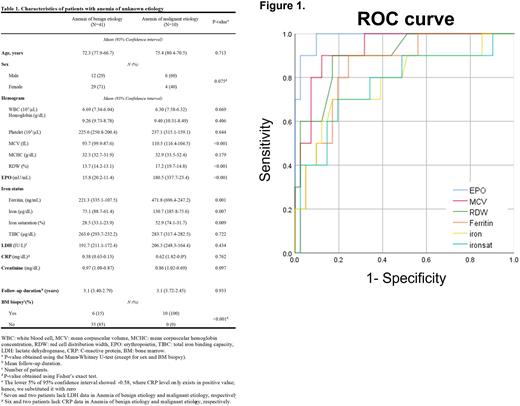Abstract
Background: Anemia is a common cause of tertiary hematology referrals. However, clinicians often fail to identify the causes of anemia, especially up to a third of those in older anemic adults. Anemia of unknown etiology (AUE) is a term used when no specific causes for anemia are indicated.
Anemia is relatively more commonly observed in myelodysplastic syndrome (MDS) and other hematologic malignancies than thrombocytopenia or neutropenia. Anemia is present even during the pre-diagnostic period of MDS. Thus, it is plausible to think that a few individuals with AUE may have hidden MDS. Erythropoietin (EPO) levels are known to be decreased in AUE and elevated in MDS as well as in other hematologic malignancies. Herein, we hypothesized that EPO levels are a marker of hidden hematologic malignancies in patients with AUE.
Methods: Data from patients referred to the department of hematology at Seoul National University Hospital with anemia (neither bi-cytopenia nor pancytopenia) from January 1, 2017, to July 31, 2019, were retrospectively reviewed. Patients were included in this study if they presented with anemia of unknown etiology, who had EPO measured at first visit. The subjects were divided into hematologic malignancy group and benign etiologic anemia, which were confirmed based on observation and bone marrow test results during the follow-up period
Results: Data from a total of 897 patients that presented at the hematology department with anemia without neutropenia or thrombocytopenia during the study period were analyzed. After exclusion of iron deficiency anemia, anemia with vitamin B12 or folate deficiency, hemolytic anemia, anemia associated with chronic kidney disease, anemia associated with monoclonal gammopathy, and drug-induced anemia, a total of 224 patients had anemia without clear etiology. Among them, 155 patients were excluded due to the lack of EPO data; an additional 17 patients were excluded due to loss to follow-up within 2 years. One patient developed cytopenia during the follow-up period and was recommended for a bone marrow test, which the patient refused; consequently, this patient was excluded from this study.
Finally, data from 51 patients were analyzed. Patients whose anemia did not progress and who did not develop either neutropenia or thrombocytopenia during the follow-up period were considered to have benign etiology anemia; otherwise, malignancies were suspected, and patients were recommended for bone marrow tests. Bone marrow tests were performed for 16 patients. Acute myeloid leukemia, MDS, pure red cell aplasia, and anemia of benign etiology (no evidence of malignancy) were diagnosed in two, seven, one, and six patients, respectively. Patients with bone marrow biopsy-confirmed hematologic malignancy were categorized into hematologic malignancy group; the remaining patients were categorized into the anemia of benign etiology group.
Statistically significant differences between the groups were detected in EPO level (P < 0.001), red cell distribution width (RDW) (P < 0.001), mean corpuscular volume (MCV) (P < 0.001), ferritin (P = 0.001), iron saturation values (P = 0.007), and serum iron level (P = 0.009) (Table 1). The mean EPO level in the hematologic malignancy group was approximately 10-fold higher than that in the benign anemia group (15.8 vs. 180.5 mU/mL).
The receiver operating curve (ROC) curve revealed that the EPO level of 33.8 mU/mL had sensitivity and specificity values of 90.0% and 97.6%, respectively (Figure 1). At the EPO threshold of 24.4 mU/mL, all patients with malignancy-related anemia were included. The area under the ROC curve for EPO was 0.985 (confidence interval, 0.959-1.000). The ROC curves for other parameters (RDW, MCV, ferritin, iron, and iron saturation) were obtained.
Conclusion: Our data shows that elevated serum EPO levels in AUE later confirmed to be hematologic malignancies. Besides a difference in EPO, RDW and MCV were higher in hematologic malignancy group, which was consistent with previous reports. Albeit statistically insignificant (P = 0.075), the risk of hematologic malignancy was higher among men than in women. In conclusion, this study presents preliminary evidence for the diagnostic value of EPO levels in hidden hematologic malignancy among AUE, even in the pre-MDS phase, supporting the rapid delivery of relevant interventions.
Disclosures
Koh:Sanofi Genzyme: Research Funding. Yoon:Takeda: Consultancy; Janssen Pharmaceutical: Consultancy; Chugai Pharmaceutical: Consultancy; Celgene: Consultancy; Astellas Pharma: Consultancy; Kyowa Kirin: Research Funding; Amgen: Consultancy; Novartis: Consultancy; Roche-Genetech: Research Funding; Yuhan Pharmaceutical: Research Funding; Tikaros: Consultancy.
Author notes
Asterisk with author names denotes non-ASH members.


This feature is available to Subscribers Only
Sign In or Create an Account Close Modal